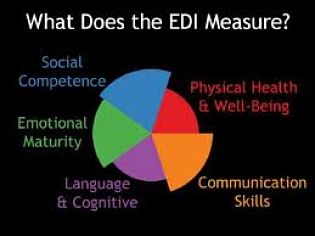
Early Development Instrument - EDI
A Snapshot of Young Children's Development in Hidalgo-Willacy Counties, Texas

Thanks to the support of local teachers, Hidalgo-Willacy Counties recently completed a community school readiness assessment using the Early Development Instrument (EDI).This report summarizes findings from the EDI, both for the community as a whole and for local neighborhoods. We hope this report will serve as a catalyst for bringing together individuals, organizations and community leaders working to improve school readiness and create better environments for our children.
The EDI is a population measure of school readiness, which means that it collects information about kindergarten age children in participating geographic areas and then creates an overall snapshot of their developmental progress. The EDI does not label or identify individual children with specific problems. Instead, it looks at how experiences at home and in the community can help prepare children for the school environment.
The EDI provides local leaders with the information they need to evaluate school readiness, plan how to improve programs and supports, and better coordinate services to help children develop and learn before and during their school years.
The EDI provides information about children in five developmental areas that are known to affect well-being and school performance:
- Physical health and well-being
- Social competence
- Emotional maturity
- Language and cognitive skills
- Communication skills and general knowledge
Understanding EDI Results
EDI results are reported as the percentage of children who are “developmentally vulnerable” and “on track” in each of the five areas. Children who score at or below the 10th percentile of the national EDI population in each area are considered developmentally vulnerable, and those who score above the 25th percentile in each area are considered on track.
Thoughtful interpretation of results. In order to use the EDI Community Profile for effective local planning and improvement efforts, it is important to consider a variety of factors that will further the understanding about what is working in neighborhoods for young children.
To do this, planners should consider community characteristics, such as the percentage of families living in poverty or the degree of linguistic isolation. They should also consider community assets such as investments made by the region that are dedicated to young children and the quantity, quality, and accessibility of services.
The results in this Snapshot reflect data collection by participating kindergarten teachers during the 2014-2015 school year. In addition, data were combined with the prior two years for schools that did not collect data again in 2014-2015, if applicable.
Lastly, this Snapshot reflects all valid records for children who live or go to school in the community.
EDI Snapshot 2015 for Hidalgo and Willacy Counties (PDF)
Hidalgo Willacy Counties Map Book 2015 - (PDF, 50MB)
Reference Guide to EDI Community Profile 2015 (PDF)
Hidalgo Willacy Tables 2015 (Excel)


